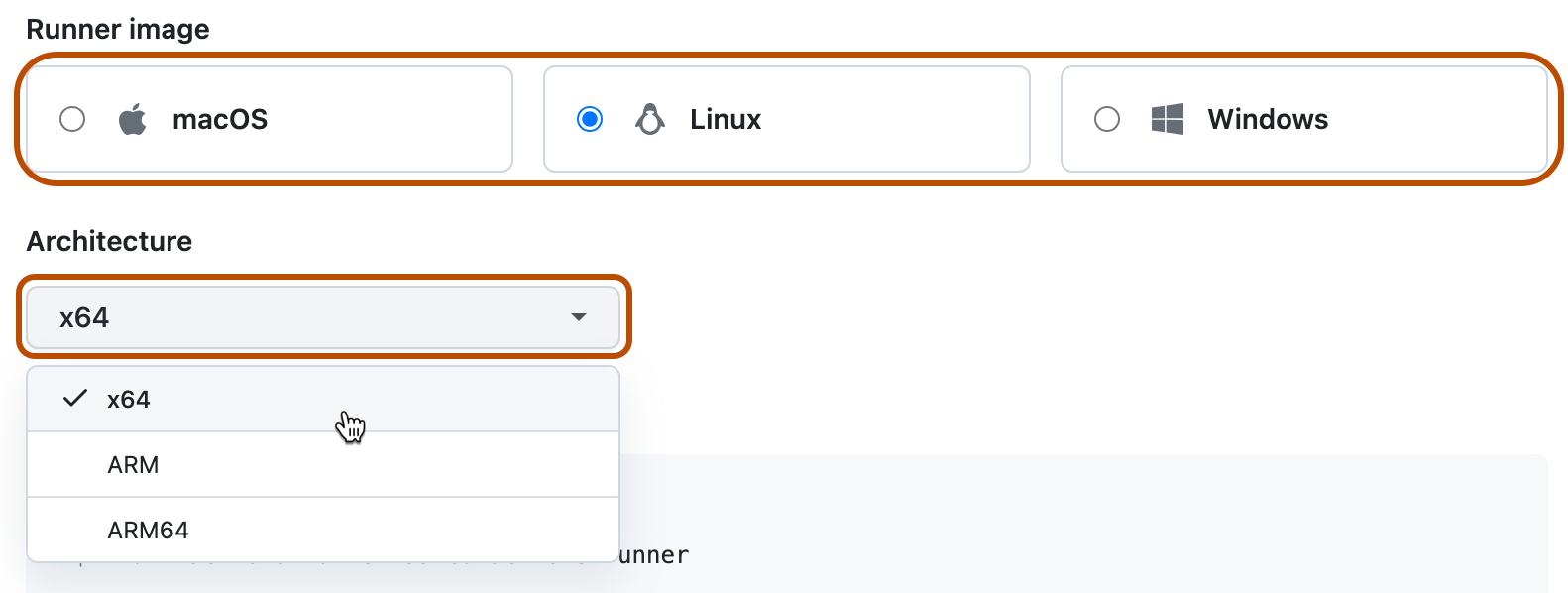경고
프라이빗 리포지토리에는 자체 호스팅 실행기만 사용하는 것이 좋습니다. 퍼블릭 리포지토리의 포크가 워크플로에서 코드를 실행하는 끌어오기 요청을 만들어 자체 호스팅 실행기 컴퓨터에서 위험한 코드를 실행할 수 있기 때문입니다.
For more information, see 보안 사용 참조.
Prerequisites
Before you add a self-hosted runner, you should understand what they are and how they work. See Self-hosted runners.
Additionally, you must meet the following requirements:
- 사용자 환경에서 자체 호스팅 실행기로 사용할 컴퓨터에 액세스할 수 있어야 합니다.
Adding a self-hosted runner to a repository
You can add self-hosted runners to a single repository. To add a self-hosted runner to a user repository, you must be the repository owner. For an organization repository, you must be an organization owner or have admin access to the repository.
For information about how to add a self-hosted runner with the REST API, see 자체 호스트형 실행기에 대한 REST API 엔드포인트.
참고 항목
조직 소유자는 리포지토리 수준의 자체 호스트형 실행기를 만들 수 있는 리포지토리를 선택할 수 있습니다.
자세한 내용은 조직의 GitHub Actions 사용 안 함 또는 제한을(를) 참조하세요.
-
GitHub에서 리포지토리의 기본 페이지로 이동합니다.
-
리포지토리 이름 아래에서 설정을 클릭합니다. "설정" 탭이 표시되지 않으면 드롭다운 메뉴를 선택한 다음 설정을 클릭합니다.

-
왼쪽 사이드바에서 작업을 클릭한 다음 길행기를 클릭합니다.
-
Click New self-hosted runner.
-
자체 호스팅 실행기 컴퓨터의 운영 체제 이미지 및 아키텍처를 선택합니다.

-
실행기 애플리케이션을 다운로드하고 자체 호스팅 실행기 컴퓨터에 설치하는 방법을 보여 주는 지침이 표시됩니다.
자체 호스팅 실행기 컴퓨터에서 셸을 열고 표시되는 순서대로 각 셸 명령을 실행합니다.
참고 항목
Windows에서 자체 호스팅 실행기 애플리케이션을 서비스로 설치하려면 관리자 권한으로 셸을 열어야 합니다. 또한 Windows 시스템 계정이 실행기 디렉터리에 액세스할 수 있도록 자체 호스팅 실행기 애플리케이션의 디렉터리로
C:\actions-runner를 사용하는 것이 좋습니다.지침은 다음 작업을 완료하는 단계를 안내합니다.
- 자체 호스팅 실행기 애플리케이션 다운로드 및 추출
config스크립트를 실행하여 자체 호스팅 실행기 애플리케이션을 구성하고 GitHub Actions에 등록합니다.config스크립트에는 요청을 인증하기 위해 대상 URL 및 자동으로 생성된 시간 제한 토큰이 필요합니다. 토큰은 1시간 후에 만료됩니다.- Windows에서
config스크립트는 자체 호스팅 실행기 애플리케이션을 서비스로 설치할지 묻습니다. Linux 및 macOS의 경우 실행기 추가를 완료한 후 서비스를 설치할 수 있습니다. 자세한 내용은 Configuring the self-hosted runner application as a service을(를) 참조하세요.
- Windows에서
- 자체 호스팅 실행기 애플리케이션을 실행하여 컴퓨터를 GitHub Actions에 연결합니다.
자체 호스트 실행기를 성공적으로 추가했는지 확인
자체 호스트형 실행기를 추가하는 단계를 완료하면 이제 실행기와 실행기 상태가 "실행기"에 나열됩니다.
실행기에서 작업을 수락하려면 자체 호스트 실행기 애플리케이션이 활성화되어 있어야 합니다. 실행기 애플리케이션이 GitHub에 연결되어 작업을 받을 준비가 되면 머신의 터미널에 다음 메시지가 표시됩니다.
√ Connected to GitHub
2019-10-24 05:45:56Z: Listening for Jobs
For more information, see 자체 호스트형 실행기 모니터링 및 문제 해결.
Adding a self-hosted runner to an organization
You can add self-hosted runners at the organization level, where they can be used to process jobs for multiple repositories in an organization. To add a self-hosted runner to an organization, you must be an organization owner. For information about how to add a self-hosted runner with the REST API, see 자체 호스트형 실행기에 대한 REST API 엔드포인트.
-
GitHub에서 조직의 기본 페이지로 이동합니다.
-
조직 이름에서 설정을 클릭합니다. "설정" 탭이 표시되지 않으면 드롭다운 메뉴를 선택한 다음 설정을 클릭합니다.

-
왼쪽 사이드바에서 작업을 클릭한 다음 길행기를 클릭합니다.
-
Click New runner, then click New self-hosted runner.
-
자체 호스팅 실행기 컴퓨터의 운영 체제 이미지 및 아키텍처를 선택합니다.

-
실행기 애플리케이션을 다운로드하고 자체 호스팅 실행기 컴퓨터에 설치하는 방법을 보여 주는 지침이 표시됩니다.
자체 호스팅 실행기 컴퓨터에서 셸을 열고 표시되는 순서대로 각 셸 명령을 실행합니다.
참고 항목
Windows에서 자체 호스팅 실행기 애플리케이션을 서비스로 설치하려면 관리자 권한으로 셸을 열어야 합니다. 또한 Windows 시스템 계정이 실행기 디렉터리에 액세스할 수 있도록 자체 호스팅 실행기 애플리케이션의 디렉터리로
C:\actions-runner를 사용하는 것이 좋습니다.지침은 다음 작업을 완료하는 단계를 안내합니다.
- 자체 호스팅 실행기 애플리케이션 다운로드 및 추출
config스크립트를 실행하여 자체 호스팅 실행기 애플리케이션을 구성하고 GitHub Actions에 등록합니다.config스크립트에는 요청을 인증하기 위해 대상 URL 및 자동으로 생성된 시간 제한 토큰이 필요합니다. 토큰은 1시간 후에 만료됩니다.- Windows에서
config스크립트는 자체 호스팅 실행기 애플리케이션을 서비스로 설치할지 묻습니다. Linux 및 macOS의 경우 실행기 추가를 완료한 후 서비스를 설치할 수 있습니다. 자세한 내용은 Configuring the self-hosted runner application as a service을(를) 참조하세요.
- Windows에서
- 자체 호스팅 실행기 애플리케이션을 실행하여 컴퓨터를 GitHub Actions에 연결합니다.
자체 호스트 실행기를 성공적으로 추가했는지 확인
자체 호스트형 실행기를 추가하는 단계를 완료하면 이제 실행기와 실행기 상태가 "실행기"에 나열됩니다.
실행기에서 작업을 수락하려면 자체 호스트 실행기 애플리케이션이 활성화되어 있어야 합니다. 실행기 애플리케이션이 GitHub에 연결되어 작업을 받을 준비가 되면 머신의 터미널에 다음 메시지가 표시됩니다.
√ Connected to GitHub
2019-10-24 05:45:56Z: Listening for Jobs
For more information, see 자체 호스트형 실행기 모니터링 및 문제 해결.
참고 항목
보안상의 이유로 퍼블릭 리포지토리는 기본적으로 실행기 그룹에서 실행기를 사용할 수 없지만, 실행기 그룹의 설정에서 이를 재정의할 수 있습니다. 자세한 내용은 Managing access to self-hosted runners using groups을(를) 참조하세요.
Adding a self-hosted runner to an enterprise
If you use GitHub Enterprise Cloud, you can add self-hosted runners to an enterprise, where they can be assigned to multiple organizations. The organization owner can control which repositories can use it. For more information, see the GitHub Enterprise Cloud documentation.
Next steps
You can set up automation to scale the number of self-hosted runners. For more information, see Self-hosted runners reference.